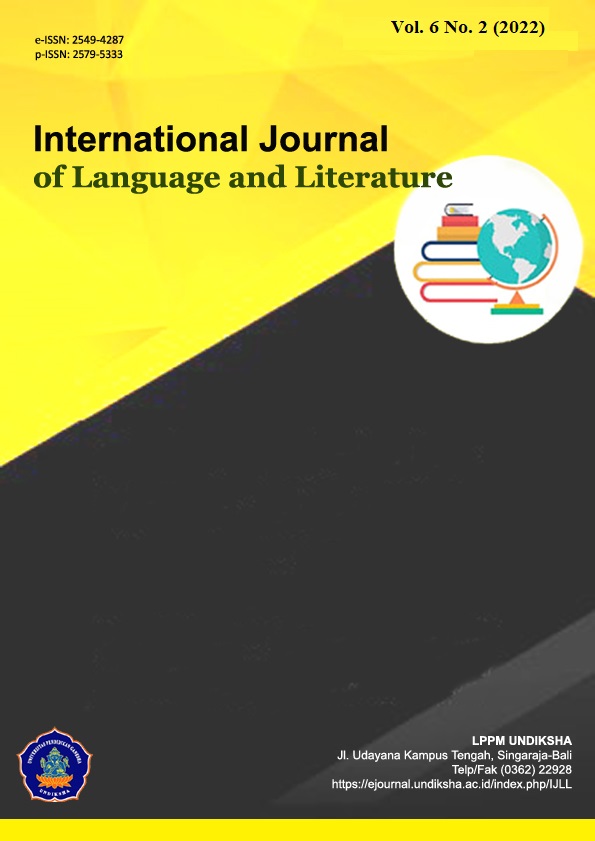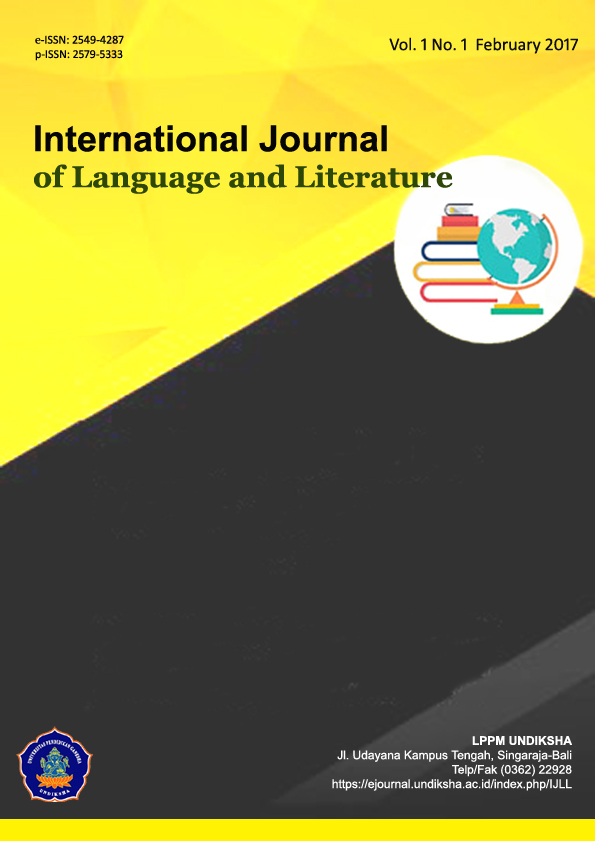Lexicons in Baris Demang Demung Dance Costumes at Banjar Tegal Village
DOI:
https://doi.org/10.23887/ijll.v6i2.57365Keywords:
Baris Demang Demung Dance, Lexicons, Cultural MeaningAbstract
Baris Demang Demung dance is a sacred dance that exists at Banjar Tegal Village, Singaraja, Bali. This study was designed in a descriptive qualitative study. The focus of this study was to find out the lexicons and the cultural meaning of costumes used by the dancers of Baris Demang Demung dance. This study applied observation and interview methods to collect the data and totally supported with the three selected informants. The obtained data were analyzed qualitatively and descriptively. The result of this study showed that t here were 27 lexicons in the dance costumes which were divided into three types namely costumes in Baris Demang Demung (8 lexicons), costumes in Prebangsa/King (14 lexicons), and costumes in Potet (10 lexicons). However, 5 of the same lexicons are found in Prebangsa/King and Potet costumes. Therefore, it can be said that there were 27 lexicons found in costumes.
References
Agung, A. A. G. P. (1981). Beberapa tari upacara dalam masyarakat Bali. Direktorat Jenderal Kebudayaan.
Baydak, A.V., Scharioth, C., & Il’yashenko, I.A. (2015). Interaction of language and culture in the process of international education. Procedia - Social and Behavioral Sciences. 14-18. DOI: https://doi.org/10.1016/j.sbspro.2015.11.567
Crystal, D. (2000). Language Death. Cambride University Press: New York DOI: https://doi.org/10.1017/CBO9781139106856
Farisiyah, U., & Zamzani, Z. (2018). Languange shift and language maintenance of local languages toward Indonesian. Advances in Social Science, Education and Humanities Research, 165 . Atlantis Press. DOI: https://doi.org/10.2991/iccsr-18.2018.50
Fatimatuzzakrah, F., Suktiningsih, W., & Hastuti, H. (2020). The Cultural Value of Lexicon in “Ngendang” Tradition. Kajian Linguistik dan Sastra, 5(1), 1-13. DOI 10.23917/ kls.v5i1.10425. DOI: https://doi.org/10.23917/kls.v5i1.10425
Giri, I. M. A. (2018). Pelestarian bahasa, aksara, dan sastra Bali melalui pengoptimalan tripusat pendidikan.
Purwadita: Jurnal Agama dan Budaya, 1(1).
Iryanti, V. E. (2000). Tari Bali: sebuah telaah historis (Bali dance: a historical reasearch). Harmonia: Journal of Arts Research and Education, 1(2).
Janse, M. (2003). Introduction: Language death and language maintenance. University of Amsterdam. DOI: https://doi.org/10.1075/cilt.240.02jan
Kavakli, N. (2021). The relationship between language and culture, and its implication for EFL teaching. Izmir Democracy University.
Kuo, M. M., & Lai, C. C. (2006). Linguistics across cultures: The impact of culture on second langu age learning. Journal of Foreign Language Instruction, 1(1), 1-10.
Muliartini. (2017). Eksistensi tari Baris Idih-Idih di desa pakraman Patas, desa Taro, kecamatan Tegalalang, kabupaten Gianyar. Jurnal Penelitian Agama Hindu: Institut Hindu Dharma Negeri Denpasar, 1(1), n.pag. DOI: https://doi.org/10.25078/jpah.v1i1.126
Yılmaz, A., Çekiç, A., Dincer, A., Yeşilbursa, A., Atak Damar, E., Zehir Topkaya, E.
& Kavanoz, S. (2020). World Englishes and culture in English as a foreign language (EFL) education. Ankara: Vizetek.
Downloads
Published
How to Cite
Issue
Section
License
Copyright (c) 2023 Kd Astri Nirwitta Wijayanti, I Gede Budasi, Putu Eka Dambayana S

This work is licensed under a Creative Commons Attribution-ShareAlike 4.0 International License.
IJLL Journal provides immediate open access to its content on the principle that making research freely available to the public to supports a greater global exchange of knowledge.

This work is licensed under a Creative Commons Attribution-ShareAlike 4.0 International License








